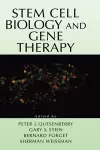
Stem Cell Biology and Gene Therapy
4 contributors - Hardback
£237.95
Lawrence R. Edelstein, Ph.D. is a neuroscientist and pharmaceutical industry consultant with research interests in multisensory convergence/integration (claustrum) and intercellular communication (exosomes, telocytes). His interest in exosomes was fueled by a theme issue he guest-edited with John Smythies and Denis Noble entitled “Epigenetic information-processing mechanisms in the brain (2014; https://royalsocietypublishing.org/toc/rstb/369/1652). That undertaking proved to be the impetus for a series of peer-reviewed articles in which he and his colleagues theorized as to the whys and wherefores of the multifunctional roles played by seemingly omnipresent and phyla-agnostic exosomes. In addition, Dr. Edelstein is co-editor (along with John Smythies and Vilayanur S. Ramachandran, M.B.B.S., Ph.D., Hon. F.R.C.P.) of the book Claustrum - Structural, Functional and Clinical Neuroscience (2014; www.elsevier.com/books/the-claustrum/smythies/978-0-12-404566-8). John Raymond Smythies, M.B. B.Chir., M.D., F.R.C.P., F.R.C. Psych. (1922-2019) was the Director of the Integrative Neuroscience Program in the Department of Psychology at the University of California San Diego. As a pre-eminent neuropsychiatrist and neuroscientist he made significant contributions to both these disciplines. Together with Humphry Osmond he developed the first biochemical theory of schizophrenia - the transmethylation hypothesis. This has recently come back into focus following the finding that DNA methylation is abnormal in schizophrenia. He made extensive contributions to knowledge in a number of fields including the neuropharmacology of psychedelic drugs; the functional neuroanatomy of synapses with particular regard to the role of synaptic plasticity, endocytosis and redox factors; the role in the brain of orthoquinone metabolites of catecholamines; and, in particular, theories of brain-consciousness relations. More recently he developed foundational hypotheses and theories specific to the function of exosomes, telocytes and the claustrum, and on epigenetic processes in information processing in the brain. Professor Smythies served as President of the International Society of Psychoneuroendocrinology from 1970-1974, Consultant to the World Health Organization from 1963-1968, and Editor of the International Review of Neurobiology from 1958-1991. He was elected a member of the Athenaeum in 1968. He held the positions of Professor Emeritus and the Charles Byron Ireland Professor of Psychiatric Research at the University of Alabama Medical Center at Birmingham, Visiting Scholar at the Center for Brain and Cognition, University of California San Diego, and Senior Research Fellow at the Institute of Neurology, University College London. He published over 240 scientific papers and sixteen books. https://en.wikipedia.org/wiki/John_Raymond_Smythies Peter J. Quesenberry, M.D., is the Paul Calabresi Professor of Oncology at The Warren Alpert Medical School of Brown University. He received his medical degree from the University of Virginia, completed residency at University Hospital and Boston City Hospital in Boston, MA, and completed a Hematology/Oncology Fellowship at St. Elizabeth's Hospital. Professor Quesenberry is a leading investigator in stem cell biology and extracellular vesicle research. He was President of the International Society of Hematology, editor of the journal Experimental Hematology from 1990-1998 and the leukocyte editor for the Year Book of Hematology from 1987-1998. More recently he is a co-editor-in-chief for the Journal of Extracellular Vesicles. Denis Noble, C.B.E., Ph.D., F.R.S. is a British biologist who held the Burdon Sanderson Chair of Cardiovascular Physiology at the University of Oxford from 1984 to 2004 and was appointed Professor Emeritus and co-Director of Computational Physiology. He is one of the pioneers of systems biology. Professor Noble developed the first viable mathematical model of the working heart in 1960 using his discovery, with his supervisor Otto Hutter, of two of the main cardiac potassium ion channels. These discoveries were published in Nature (1960) and The Journal of Physiology (1962). The work was later developed with Dick Tsien, Dario DiFrancesco, Don Hilgemann and others to become the canonical models on which more than 100 cardiac cell models are based today. He was elected President of the International Union of Physiological Sciences (IUPS) at its Congress in Kyoto in 2009 and was re-elected for a second term at the 2013 Congress in Birmingham, UK. He is the author of the first popular book on systems biology, The Music of Life, and his most recent lectures concern the implications for evolutionary biology. Professor Noble has published more than 500 papers and 11 books. https://en.wikipedia.org/wiki/Denis_Noble